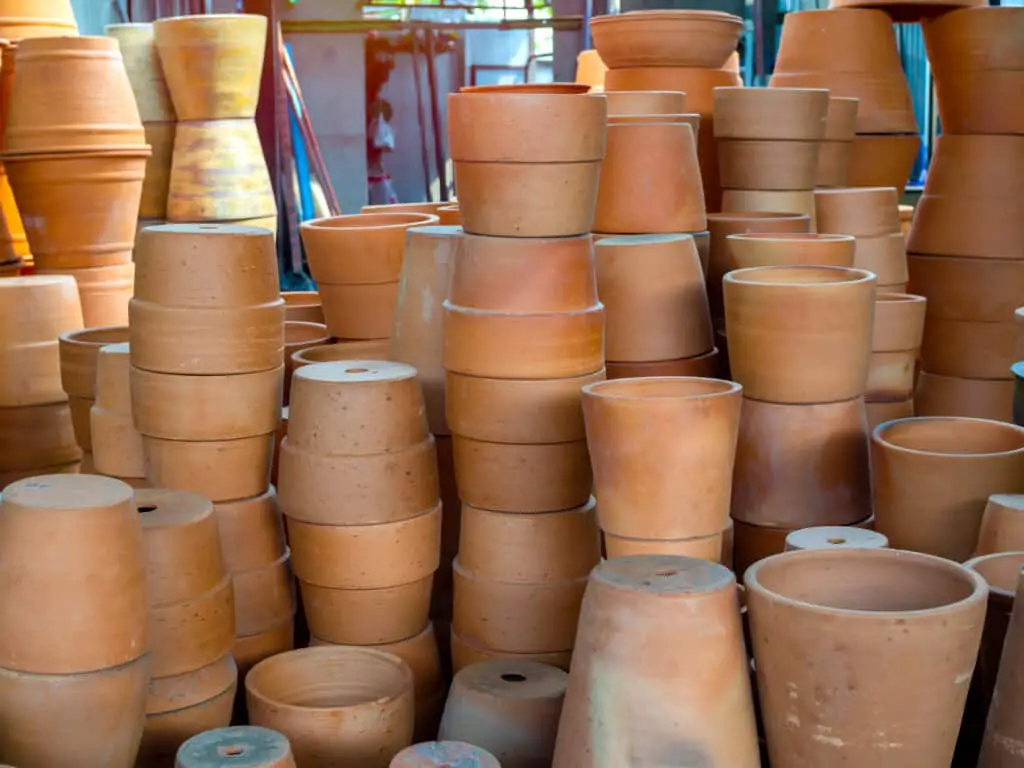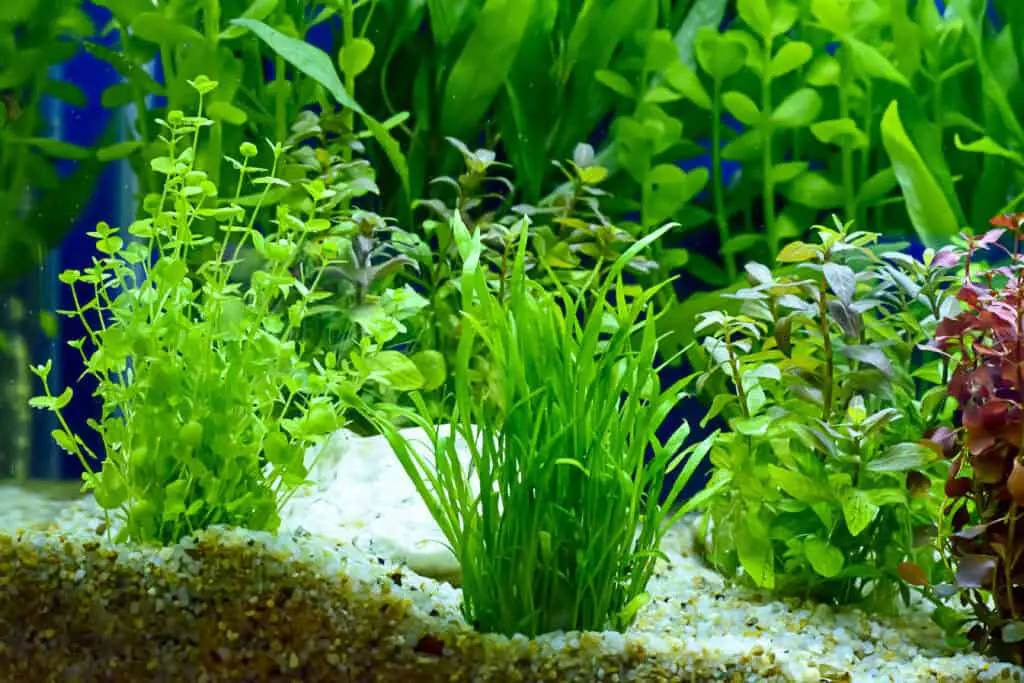
Fish-keeping hobbyists are always looking for a unique way to add new aesthetics to their tanks, something that can help enhance the beauty and visual balance.
One of these trends is the addition of potted aquarium plants, which has the benefit of adding a different look and feel to a planted tank.
But is keeping your plants in pots beneficial, and can you do this?
You can keep aquarium plants in pots in a tank, some plants such as Anubias and Java Fern can prefer this and may have better success than other plants because of the moderate growth and root structure they have compared to other plants.
It is a planting method that is very much plant species specific to know if it is the best for your tank and plant.
Let’s dive into the considerations that should be made to determine if your tank, and the plants are best suited for this planting method.
Determining If Potted Plants Are Right For You: Advantages and Disadvantages
When it comes to the ability to have plants in pots for your tank, it is a resounding yes that you can.
However, like most things, there are some caveats, and things to consider to determine if something you can do in placing plants in pots, is something that will provide both what you want them to, and if they are not harmful to the plants you want to place in the pots.
Here are some things to consider to be able to make an informed decision.
Advantages
The first is its unique aesthetic, most have their plants placed in the ground, floating, or attached to a piece of wood or rock.
Having the plant potted allows you to add something to enhance, or put focus on a plant that would otherwise most likely get lost with the other plants.
Secondly, potted aquarium plants allow for easy rearrangement of your tank and plants.
If you are someone who enjoys making visual changes to your tank often, you may want to consider having potted plants.
This provides the option to move these plants without disturbing the substrate, or root system.
This flexibility is something not experienced if all the plants are planted in the substrate.
Finally, potted plants are somewhat limited in how much they can grow, this is helpful in smaller tanks, or where there may be other plants already in the tank, and this will help the new plants from overtaking the tank.
This controlled growth can be beneficial in creating a balanced tank ecosystem.
Disadvantages
If you desire to have the plants grow and expand, then having these plants placed in pots is not the best plan.
Though the pots will protect the root system of the plants, they will also restrict the amount of development and growth they can achieve.
Potted plants will also require in most cases additional fertilizer if using root tabs.
Because they are essentially separated from the substrate, and on their own, additional root tabs could be necessary to place them in the pots themselves to become beneficial to the plant.
The pot itself introduces two possible disadvantages.
One is that the material and makeup of the chosen pot must be verified and completely considered.
If possible look for pots specifically designed for aquariums, or make sure no type of residue is present when adding them to your tank to make sure there isn’t any foreign substance accidentally getting added, or that the material is inert and will not cause changes to your water parameters.
It is also a big limiter in space. One or two potted plants may add a special aesthetic feel, however, it may become more cluttered over time if more potted plants are added, as well as only so many potted plants can be added because the pots themselves are taking more room than planted plants directly in the substrate.

Choosing the Right Plants
Some plants will benefit more and thrive in pots better than others.
The typical plants that are normally associated with doing well in cramped spaces will be the best choices if wanting to add potted plants.
Plants such as Java Fern and Anubia give great examples of plants that can thrive when placed in a pot.
They are good choices because of the moderate growth, and root structure, making it so they don’t require the need to sprawl out across the tank to thrive.
Suppose you have the desire to add potted plants to your aquarium. In that case, it is a better choice to find plants similar to the Anubias and Java Fern, that are already suited for pots, rather than trying to have plants not known for being potted and trying to make that work.
That does not mean that other plants not known for being in pots will not survive or even thrive, but it will give a better chance at success if you use plants like Anubias and Java Fern.

Choosing the Right Pots and Substrate
It is important to make the right choice in pot and substrate to help make the addition of a potted plant a successful one. Here are things to consider:
Material and Condition of Pots
There are many options when it comes to possible pots to use, however one must be careful to be sure they aren’t introducing toxic chemicals into their tank.
The very best option for pots is terracotta which can be found in many garden sections at stores.
These are the same pots used as flower pots and are made of clay and hardened by heat.
You also want to make sure there isn’t any other addition to the pots such as paint, dyes, or glazes to make sure nothing can leach into your tank water.
It is also best to use new pots, instead of old pots that have been used for the fact that there is no way of knowing if they were exposed at some point to fertilizer, weed killer, or bug spray that could leach into the water and cause harm to your plants and tank inhabitants.
Size
These terracotta pots will come in many sizes, so it is important to factor in both your tank and its size, the area which you want to place your potted plant into to make sure there is enough clearance, and the plant itself you are planning to use to make sure there is enough room for its root system to grow and establish inside of the pot.
Substrate
Because the potted plant behind is separate from the tank’s substrate, you do have the ability to have a different type inside of the pot.
While it’s not a bad thing to simply use the same substrate as the tank, it does provide you the opportunity to use one that is more geared to plant growth without the large cost it would require to use the same optimal plant substrate for the entire tank.
You also have to remember that the plant is mostly closed off from the nutrients available in the tank’s substrate, and has a smaller area to pull from, unlike plants in the substrate that can grow their roots to reach further areas.
Options like aquarium soil or clay pellets can offer good nutrient support and good anchorage for the plant.
The plant will also benefit from adding root tabs to the substrate in the pot.
Final Thoughts
Having some plants in your aquarium in pots is a completely viable option, that can help assist in providing flexibility in plant placement, and controlling plant growth and expansion.
Other than being a potted plant, the care needed is very similar to any other aquarium plant.
While there should be careful considerations made involving the choice of plant, pots, and care, the correct choices can lead to an appealing and unique planted tank look.
Some plants are known in the hobby such as anubias and java fern that do well as potted plants, but don’t be afraid to experiment with other plants, along with the use of different substrates and fertilizers to find the right balance that works for you and your tank best.
